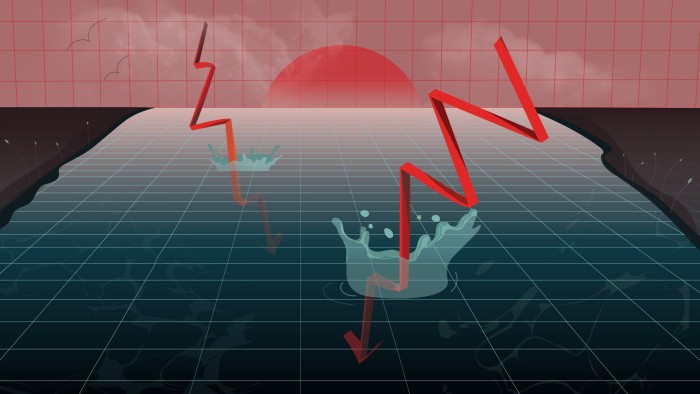Five lessons from today’s bond market turmoil


Roula Khalaf, Editor of the FT, selects her favourite stories in this weekly newsletter.
Until recently, the so-called “$TLT” exchange traded fund — which tracks long-term Treasuries — seemed dull as ditchwater. The price used to move in tiny increments with modest trading volumes, making it suitable for widows and orphans — risk-averse investors, in other words.
Not now. On Tuesday there were 71mn daily trades of the ETF, many times higher than usual. And the price has fallen 3 per cent this week alone, and is now 20 per cent down on the last six months, and 50 per cent since early 2020. That exceeds even the stock market rout after the dotcom bubble.
What should bruised investors conclude? There are five key points to understand. The first is that the current bond market pattern is not — repeat, not — just a replay of what we have seen in recent years. When the US Federal Reserve started hiking rates 18 months ago, short-dated yields rose as short-term bond prices fell (these move inversely.)
However, long-term rates did not surge, apparently because investors assumed that inflation and growth would eventually fall.
This year, however, those long rates have jumped, even though short rates have stabilised (seemingly because central bank tightening is almost over). That suggests that long rates are moving because of deeper structural shifts in the supply and demand for bonds; so it is not “just” about the Fed.
The second key point is that while the pace of bond price falls is startling by historical standards, the actual level of rates is not. On the contrary, during most of the 20th century, a 4.8 per cent 10-year Treasury yield was considered normal, if not benign.
Thus what is most bizarre today, from a long-term perspective, is not that yields are rising, but that they were so low during the past decade. Even odder, the yield curve is still slightly inverted (ie short rates are higher than longer ones.)
Third, if you want to understand the structural shifts driving the rate swing, don’t just look at economic data. Yes, investors have recently raised their projections for future inflation and growth. And, yes, concern is mounting about America’s debt, which has doubled to $33tn since 2011 amid political gridlock.
But market metrics of inflation expectations have actually not changed recently. And that debt pile has been sitting in plain sight for a long time; hence the Congressional dramas.
So that leads to a fourth key point: the recent bond falls are putting a spotlight on the behaviour of non-American investors.
One factor that seems to be affecting market sentiment is a fear that Japanese investors could sell Treasuries to buy yen assets if the Bank of Japan lets its 10-year yield rise above 1 per cent.
Another is China. Some analysts, such as Torsten Slok of Apollo, think that the Chinese are reducing US Treasury purchases, either due to geopolitical tensions or because of financial strains at home. And the Treasury International Capital (“TIC”) data seems to support this: Chinese holdings fell from $939bn to $821bn over the past year.
But Brad Setser of the Council on Foreign Relations thinks this TIC series is misleading: not only are the Chinese buying US agency bonds, but they are buying US assets through European entities such as Euroclear, that are excluded. If included, he thinks “China’s reported holdings of US assets look to be basically stable at between $1.8tn and $1.9tn.”
Either way, the most important point is that nobody knows for sure, since the data is woefully opaque.
Markets today thus echo the risk pattern of 2007: a heavily interconnected system is highly exposed to developments in a murky, little-understood corner of finance — but instead of subprime mortgages, the issue is Beijing’s appetite for Treasuries.
The fifth point is that amid this uncertainty there is at least one issue that is crystal clear: what is happening is bad news for the White House.
Savvy corporate treasurers have already scrambled to restructure their debt to lock in the past decade’s low borrowing costs, for as long as possible. But Janet Yellen, US Treasury secretary, has not been able to do this. That means debt servicing costs will soon explode; indeed, they are already doing so, prompting chatter about bond “vigilantes”.
Some investors think (or pray) that this fiscal squeeze will prod the Fed to cut short-term rates.
Others think the Fed will be forced to act to prevent a replay of this spring’s Silicon Valley Bank drama; tumbling bond prices are once again creating losses in bank and insurance portfolios.
And if the Fed does slash short-term rates, that might persuade leveraged investors such as hedge funds to start buying long-term Treasuries again.
But, as bond guru Bill Gross notes, it is hard to imagine the Fed cutting rates if inflation stays above 3 per cent. In that case, long rates will need to rise even higher — say above 5 per cent — to attract investors, given the looming wave of debt issuance.
The bottom line, then, is that people holding that not-so-boring long-bond ETF could face more drama. But then nobody ever said that exiting quantitative easing would be easy; the real challenge has barely even begun.
Comments